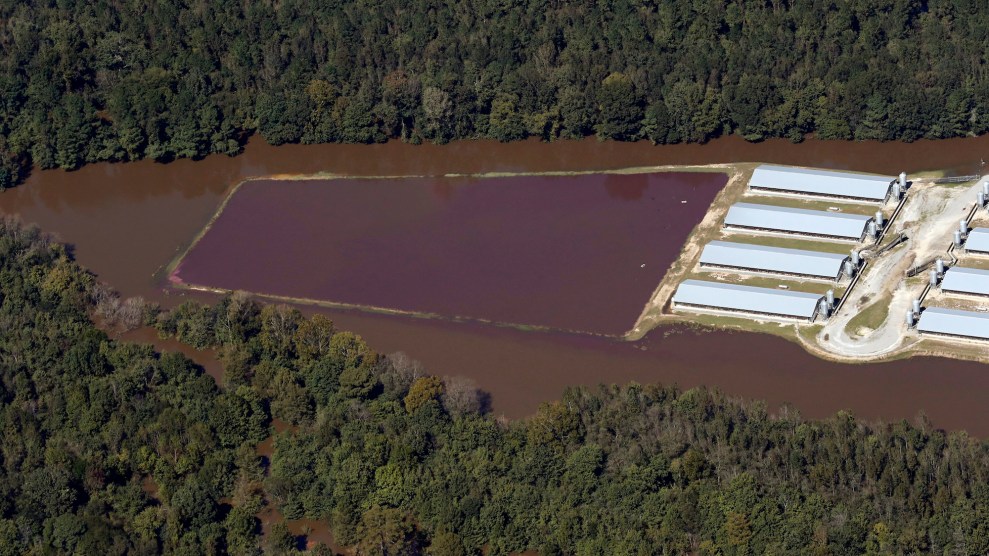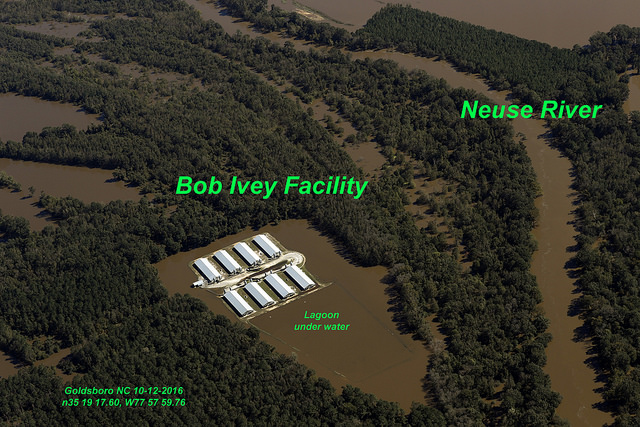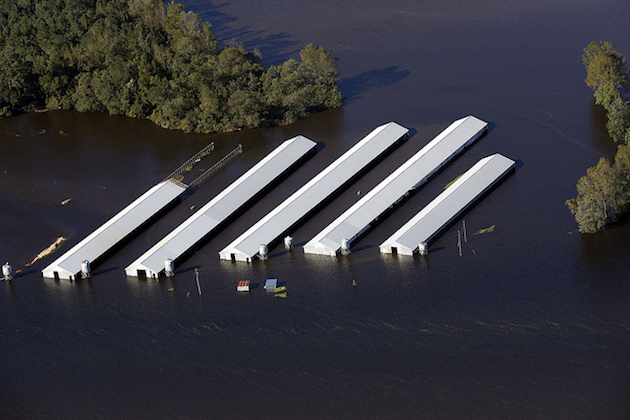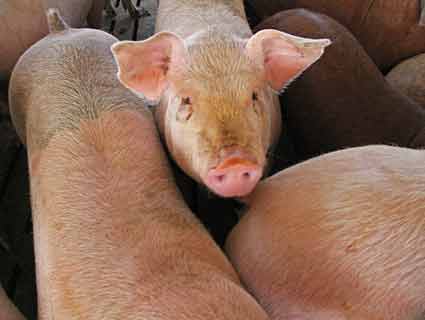
A flooded hog-manure lagoon in Wayne County, North Carolina, photographed on October 11. Manure lagoons like the one in the picture often take on a grotesque purple hue, the result of microbrial changes as fecal matter breaks down. <a href="https://www.flickr.com/photos/waterkeeperalliance/30281573595/in/album-72157673749082442/">Rick Dove</a>/Waterkeeper Alliance
Rivers in eastern North Carolina, still swollen from Hurricane Matthew’s downpours, are flooding a region that teems with hog and poultry farms. As many as 5 million chickens and turkeys had already died as of Wednesday, Reuters reports. The North Carolina Department of Environmental Quality has so far not released an estimate of hog deaths, but they could be steep.
That’s because North Carolina is home to one of the globe’s highest concentrations of pork production. Clustered mainly in five counties in the state’s southeast region, 2,000 large-scale hog operations churn out about 10 million hogs annually, more than any other state except Iowa. And it’s not just animal corpses that are likely to stream out of inundated farms. Together with the state’s chicken houses, North Carolina’s hog barns generate 10 billion gallons of fecal waste annually, “enough to fill more than 15,000 Olympic-size swimming pools,” reports Environmental Working Group, much of it stored in open cesspools known as “lagoons.”
Hog manure is loaded with pathogenic bacteria, including antibiotic-resistant ones, antibiotic residues, and plenty of nitrate, which fouls drinking water and also feeds dead-zone-causing algae blooms. University of North Carolina researcher Steve Wing has spearheaded a rising tide of research documenting how the state’s hog facilities harm nearby residents, who are disproportionately low-income African Americans.
What happens when storm floods meet vast confined hog-rearing facilities and their lagoons? The Waterkeeper Alliance’s Rick Dove has been taking extraordinary aerial photos like the one above. Typical hog confinements, like the white buildings on the right in that photo, hold about 2,000 hogs each. According to the Environmental Working Group, there are 586,092 hogs in Wayne County and 229 manure lagoons.
Waterkeeper Alliance’s Dove told me that in his recent airplane forays over eastern North Carolina, “Some of those lagoons were so submerged that we didn’t even know they were there when we photographed them.”
In many cases, Dove said, he didn’t realize until he and his team got back on the ground and compared their aerial photos with Google Earth images. As an example, he pointed to the image below, taken of a hog operation in Seven Springs, Wayne County.

The Google Earth image of the same site shows no fewer than three lagoons that are submerged in the above photo.

Here’s another one of Dove’s photos, taken October 10, capturing an obviously flooded lagoon in Wayne County.

Another one, taken October 12, shows just how close some Wayne County hog operations are to the Neuse River.

The next two, captured on October 10 and 11, respectively, show scenes from Duplin County, where a staggering 2.3 million hogs are raised each year, more than any other US county. The state has not released information on the extent of hog deaths in flooded facilities, but these images paint a grim picture.


In recent years, North Carolina’s eastern counties have seen hundreds of industrial-scale chicken houses appear, adding yet another source of concentrated manure. They, too, are prone to flooding, as this photo shows.

Back in 1999, Hurricane Floyd wrought similar havoc in North Carolina hog country, washing untold amounts of raw manure and hog corpses into watersheds and creating a 350-square-mile dead zone in coastal estuaries. Here’s how Jeff Tietz described it in a seminal 2006 Rolling Stone piece “Boss Hog”:
Hurricane Floyd washed 120,000,000 gallons of unsheltered hog waste into the Tar, Neuse, Roanoke, Pamlico, New and Cape Fear rivers. Many of the pig-shit lagoons of eastern North Carolina were several feet underwater. Satellite photographs show a dark brown tide closing over the region’s waterways, converging on the Albemarle-Pamlico Sound and feeding itself out to sea in a long, well-defined channel. Very little freshwater marine life remained behind. Tens of thousands of drowned pigs were strewn across the land. Beaches located miles from Smithfield lagoons were slathered in feces. A picture taken at the time shows a shark eating a dead pig three miles off the North Carolina coast.
It’s still too early to tell whether the damage from Matthew will reach or surpass that scale as rivers continue to flood. A North Carolina Department of Environmental Quality spokesperson told Reuters that many hog lagoons have been inundated and are leaching into waterways. Dove flew similar photography runs after Floyd in ’99, and says that from his observation, some places have been harder hit by Matthew than by Floyd, and others have gotten off easier. And rivers are still cresting, causing new floods as storm waters make their way east through North Carolina’s hog counties, Dove said. “It will be days before we know the extent of the damage,” he added.

















